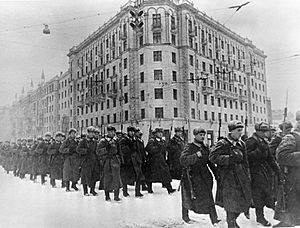Battle of Moscow facts for kids
Quick facts for kids Battle of Moscow |
|||||||
|---|---|---|---|---|---|---|---|
| Part of the Eastern Front of World War II | |||||||
 December 1941. Fresh forces going to the front from Moscow. |
|||||||
|
|||||||
| Belligerents | |||||||
| Nazi Germany | Soviet Union | ||||||
| Commanders and leaders | |||||||
| Fedor von Bock Heinz Guderian Albert Kesselring |
Georgy Zhukov Aleksandr Vasilevsky |
||||||
| Strength | |||||||
| As of 1 October 1941: 1,000,000 men, 1,700 tanks, 14,000 guns, Aircraft at first: 549 can be used At time of Counter offensive: 599 |
As of 1 October 1941: 1,250,000 men, 1,000 tanks, 7,600 guns, Aircraft at first: 936 (545 can be used) At time of Counter offensive: 1,376 |
||||||
| Casualties and losses | |||||||
| 280,000-400,000 | 650,000–1,280,000 (mostly captured) | ||||||
The Battle of Moscow was a very important fight during World War II. It happened on the Eastern Front between October 1941 and January 1942. This battle was a major part of the German plan to invade the Soviet Union, called Operation Barbarossa.
The main goal for Germany was to capture Moscow, the capital city of the Soviet Union. But the Soviet defenses were strong. They managed to stop the German army. After stopping the attack, the Soviets launched their own counter-attack. This forced the German forces to retreat. The Battle of Moscow was a big victory for the Soviet Union. It showed that the German army could be stopped.
Contents
What Was the Battle of Moscow?
The Battle of Moscow was a series of intense fights. It took place over a large area, about 600 kilometers (370 miles) wide. This battle was fought between the armies of Nazi Germany and the Soviet Union. It lasted for several months, from late 1941 into early 1942.
The battle had two main parts. First, the Germans attacked Moscow. Then, the Soviets defended their city. After that, the Soviets launched a strong counter-attack. This pushed the German army far back from Moscow.
Why Was Moscow Important?
Moscow was the capital city of the Soviet Union. It was also a very important center for industry and transportation. Capturing Moscow was a key goal for Germany in World War II. They believed taking the capital would make the Soviet Union surrender.
The city also had great symbolic meaning. It was a sign of Soviet power and strength. Losing Moscow would have been a huge blow to the Soviet people. It would have hurt their morale and their ability to fight.
Germany's Plan: Operation Typhoon
Germany's attack on Moscow was called Operation Typhoon. The plan was to attack the city from two main directions. One attack would come from the north. The other attack would come from the south. The goal was to surround Moscow and capture it quickly.
The German army was very powerful at the start. They had many soldiers, tanks, and guns. They had already won many battles in Europe. They expected to take Moscow easily.
The Soviet Defense
The Soviet Union knew Moscow was in danger. They brought in many extra soldiers. Some of these soldiers came from far away, like the Soviet Far East. They built strong defenses around the city. This included trenches and anti-tank barriers.
The Soviet people also helped. Many citizens, including women, dug trenches. They built barricades in the streets. Everyone worked together to protect their capital city.
The Harsh Winter
The battle took place during a very cold Russian winter. The temperatures dropped far below freezing. There was a lot of snow. The German soldiers were not ready for such extreme cold. Their equipment and vehicles struggled in the snow and ice.
The Soviet soldiers, however, were used to the cold. They had special winter uniforms. This gave them an advantage in the harsh weather. The cold weather also slowed down the German advance.
The Winter Counter-Attack
In early December 1941, the Soviet army launched a huge counter-attack. They used fresh troops and new equipment. General Georgy Zhukov led this powerful attack. The Soviets pushed the tired and cold German forces back.
The German army was surprised by the strength of the Soviet counter-attack. They were forced to retreat from Moscow. This was the first major defeat for Germany in World War II. It showed that their army was not unbeatable.
Why Was This Battle Important?
The Battle of Moscow was a turning point in World War II. It proved that the German army could be stopped. It also boosted the morale of the Soviet people. They knew they could defend their homeland.
This battle also meant that Germany could not win the war quickly. They had to fight a long and difficult war on the Eastern Front. This had a big impact on the rest of World War II.
Images for kids
-
Parade by Soviet troops on Red Square, Friday, 7 November 1941, depicted in 1949 painting by Konstantin Yuon vividly demonstrating the symbolic significance of the event
-
Soldiers dressed in Red Army uniforms carrying the standards of the military fronts of the Eastern Front on Red Square, 7 November 2018.
See also
 In Spanish: Batalla de Moscú para niños
In Spanish: Batalla de Moscú para niños


















